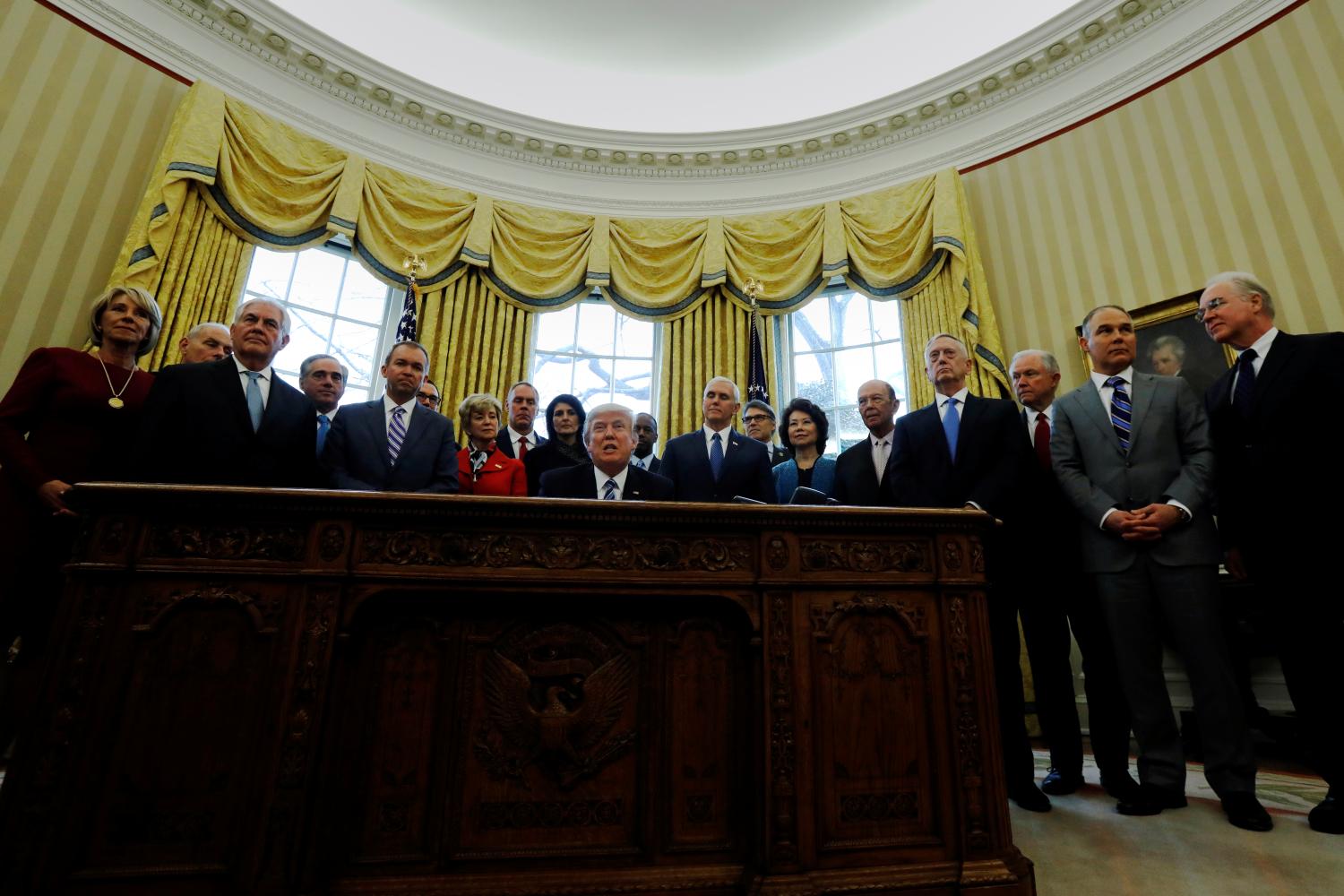Hope springs eternal that the upcoming wave of confirmation hearings for leadership roles in the Trump Administration provide a serious, thoughtful, and Twitter-free process for deliberation. At its best, these hearings can weed out nominees who are simply unsuited for the proposed role or better prepare them for their future service through serious engagement with senior legislators.
In practice over recent decades and multiple presidencies, these hearings routinely under-perform. Instead, nominee proponents from the President’s party generally attempt to move things along smoothly and secure a confirming vote as quickly as possible. Opponents will try to open cracks in the case and trip the nominee into saying something awkward and regrettable.
In the case of Rick Perry, it may well be tempting for opposition Senators and their staffs to find ways to bring back to light the likely worst minute in Perry’s political life. Yes, the stumble in a 2012 presidential debate over naming all three agencies he would like to dismantle.
This defining vignette has been shown over—and over—again, perhaps to the point where Perry feared any future obituary would begin with reference to that stumble. But we can only hope that the upcoming hearings over Perry’s suitability to serve as the Secretary of Energy navigate away from that unfortunate moment and instead engage Perry in a serious discussion of his long career in public service and vision for the future of American energy policy.
Perry served more than 14 years as Governor of Texas, following a lengthy tenure in the legislature and a stint as George W. Bush’s Lieutenant Governor. The Texas Constitution imposes numerous constraints upon any occupant of the governor’s chair and yet Perry has been a rather significant force in the major evolution of Texas energy production and use during this period. He clearly has a longer and more engaged record of public service than most other proposed members of the Trump leadership team.
The state has remained a prodigious producer and consumer of energy, perhaps most notably the expansion of oil and gas output linked to the proliferation of hydraulic fracturing and horizontal drilling techniques. But gas production has also created a window to achieve significant reductions in the use of coal in recent years, contrary to many earlier projections.
At the same time, the steady performance of natural gas has also coincided with a massive increase in wind production. It has long been known that Texas has a formidable wind resource but decades of experimentation with development produced very little until the waning years of the Bush Governorship.
This led to a major portfolio standard that was adopted in 1999 and then expanded six years later in a special session of the legislature called by Governor Perry. Texas has long since exceeded its regulatory targets but has also gone on to invest heavily in upgraded transmission capacity from wind-rich to energy-demand regions. This was funded to the tune of nearly $9 billion dollars through electricity use “fees” that in many other states would be characterized as a “tax” on consumption of power, the bulk of which are derived from fossil fuels.
In turn, Texas has relied heavily on federal tax credits to expand its wind presence, now standing as the largest generator of wind of any state (including California) and poised for continuing expansion in both wind and solar, alongside the outsized role of natural gas in a state that is decreasingly reliant on coal. The Perry era has not been at all reluctant in trying to pursue public investment strategies related to technology development and training.
He has also supported sustained energy extraction—or severance—taxes that are among the highest in the nation and continue to deposit revenues into trust funds for education. This runs contrary to some other states such as Oklahoma (home of EPA Administrator nominee Scott Pruitt) that have slashed rates in search of expanded development or others such as Pennsylvania that continue to refuse to impose such a tax.
This record suggests an energy policy that defies characterization as being driven exclusively by the workings of the marketplace. Indeed, a good number of the policy steps that Perry took in Texas are actually pretty similar to what some Democratic Governors along the coasts or in the industrial Midwest have tried in recent decades, collectively having a significant impact on energy transition and development. Perry has carefully avoided reference to these steps as linked to climate change, even when they result in reduced greenhouse gas emissions for which political credit would be claimed in bluer states.
All of this raises intriguing questions for an adult conversation in confirmation hearings about his vision for the role of government in promoting energy research and development, forging a mature partnership between Washington and statehouses, and use of incentives and subsidies to promote or discourage various energy sources.
One such topic is the future of nuclear power, even though Texas is not heavily dependent on legacy plants and has demonstrated little interest in any major expansion. But nuclear has continued to provide significant quantities of low-carbon energy alongside the growth in natural gas and renewables, while facing huge future challenges. Some states such as Illinois are plowing in massive subsidies to keep older plants operational despite their high expense. Others such as Michigan are holding back such intervention, reflected in the recent decision to close the Palisades plant in the western part of the state by 2018. New York continues to struggle with this issue, given its own nuclear inheritance at sites such as Indian Point alongside ambitious low-carbon goals.
And then there is nuclear waste and the possibility of finally addressing the high-level nuclear waste issue. This might entail a transfer of waste now stored around the nation to Nevada, despite decades of vehement opposition from that state to opening up the long-stalled Yucca Mountain facility. It might involve development of an interim facility in Andrews County, Texas, that appears eager to volunteer for the task, despite serious questions about costs and suitability. Or it might involve returning to the “consent-based” approach recommended by the Blue Ribbon Commission on America’s Nuclear Future in 2012 but largely ignored in favor of the politically-easier reliance upon on-site storage. What is the Perry Plan on this–and so much more?
The next Secretary of Energy will preside over these issues, and many others. Let’s hope that the coming hearings create a serious context for Rick Perry to draw on his record and that he proves capable of outlining a convincing vision for the next generation of American energy policy. Unlike many other Trump nominees, he has a record to defend and an opportunity to demonstrate that he is capable of more than memorizing the names of three agencies.
The Brookings Institution is committed to quality, independence, and impact.
We are supported by a diverse array of funders. In line with our values and policies, each Brookings publication represents the sole views of its author(s).







Commentary
Confirming Team Trump: Governor Perry comes to Washington
January 18, 2017